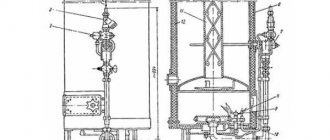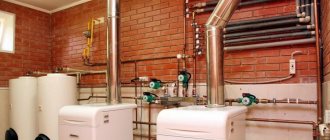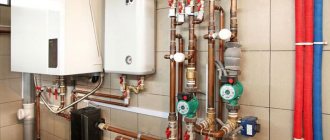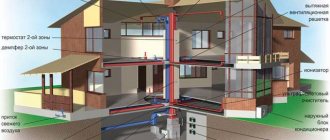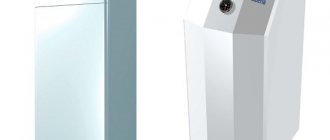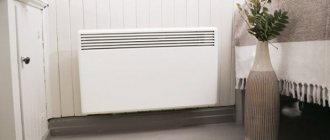Blade design features
Regarding the design features of the blades of the future generator, it should be noted that they should not be too long, and their total number usually does not exceed three.
This choice is explained by the fact that the weight of the rotating elements in this case will be less, and the risk of their destruction is sharply reduced. Note! A number of industrial designs use long and relatively heavy blades, but their design provides for a variable angle of inclination of the plane of rotation. This arrangement of the moving mechanism allows you to change the speed while simultaneously reducing the noise level
This arrangement of the moving mechanism allows you to change the speed while simultaneously reducing the noise level.
The approximate cost of the most inexpensive example of an industrial wind turbine with a power of up to 1 kW is about 50 thousand rubles. and more. For most users, this amount turns out to be absolutely unaffordable. This explains the desire of many of them to try to make a wind turbine on their own, taking advantage of the capabilities of an old, but still working self-generator.
We make air heating of a private house with our own hands: instructions with video
Before you begin installing a heating system according to the Canadian method, you need to wisely select the equipment and necessary elements: heat generator, fastening elements, sealant, air ducts, reinforced tape, grilles and much more. At the first stage of work, a main supply air duct should be installed.
Further from it, small air ducts (flexible) should be installed. This is done like this: you will need to cut small round holes in the supply air duct, install inserts in them and secure them well with tape as shown in the photo below.
The assembled air ducts are then attached to the ceiling and hidden under the frame of the suspended structure. A suspended frame for installing a ceiling allows you to reliably hide not only air ducts, but also wiring and various communications, this is very convenient when creating interiors.
It must be said that organizing such a structure and frame yourself is not at all difficult; the main thing here is to know about all the nuances, difficulties and pitfalls that you may have to encounter with this method of arrangement.
If you still haven't decided which heating system is best for heating your home, then watch the video:
Air circulation standards
According to SNiP 2.04.05-91, the general air circulation rate is 35% per hour, that is, complete replacement of exhaust air must occur within 3 hours. In this case, at least 30 m3/hour of air per person must enter the room. For the kitchen, this figure is increased to 60 m3/hour in the presence of electric stoves, and up to 90 m3/hour if a 4-burner stove is used.
Additionally, the room must be equipped with vents or folding transoms on the windows to ventilate the room and let in at least 180 m3/hour of fresh air. Sometimes a hood is used for these purposes.
In bathrooms and toilets, air circulation rates are 25 m3/hour for each room. In combined bathrooms, the norm doubles.
System Design Principles
When designing air heating systems, many important factors are taken into account. First of all, this is the heat demand of each individual room, as well as the heat loss for each room. Doors, windows, vents and other objects allow precious kilojoules of heat energy to escape.

The Buleryan stove is an economical heater option that can be used to organize air heating. A long-burning wood stove can also be an excellent solution.
The most important point is the presence of high-quality insulation of the building. If the house has plastic windows, good doors, and its facade is reliably insulated, there will be less heat loss, and heating costs can be significantly reduced. If we are talking about the reconstruction of a building, we should start with the design of insulation.
After the need for thermal energy and its costs are correlated, the power of the heating equipment is calculated and its type is selected. Then the hot air flow parameters are calculated. Special aerodynamic calculations are performed to calculate the required dimensions of the air ducts.
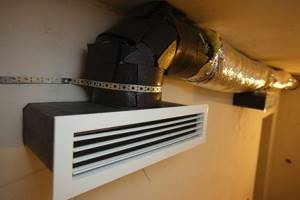
A diffuser grille is installed at the outlet of the air duct. Its size and configuration may affect the speed of air flow
You can preliminarily calculate the power of the equipment based on the following figures: for heating every 10 sq. meters of room you will need about 0.7-0.8 kW of heat. This is provided that the house is well insulated, otherwise more powerful equipment will be needed. But it is better to entrust complete design and detailed calculations to an experienced engineer.
Incorrect calculations can have a very bad effect on the state of the finished system. An unprofessionally designed air heating system is characterized by such problems as frequent equipment breakdowns, overheating of indoor air, overheating of equipment, drafts, and increased noise levels.
Simultaneously with designing an air heating system, it makes sense to think about the placement of stationary pieces of furniture in the house. Supply and exhaust grilles should be located in places away from the constant presence of people.
They also should not be hidden under cabinets, cabinets or other objects that impede the free movement of air masses.
In a multi-storey private house, it is recommended to place exhaust grilles in such a way that on the upper floors the cooled air is taken into the system from above, and on the lower floors - from below. This will ensure a more even distribution of heat throughout all rooms. Read more about how to correctly calculate air heating in this material.
Image gallery
Photo from
Inclined airflow direction
Scheme of operation of inclined warm air supply
Horizontal direction of heat supply
Vertical supply of warm air flow
Air-fired gas heating at home is more economical than other heating systems
Air-fired gas heating of a home is the most economical among all other air heating systems - unless, of course, we are talking about mains gas. Moreover, in general, any air heating is more economical than other types of heating. Why is this so? There are several reasons.
Firstly , air heating in general, including gas heating, mainly heats only the air in the house, and not the walls or floor. If you install water heating in your house, it will heat the walls to a greater extent, from which the air will already be heated. The same applies to heating with heated floors - first you will have to warm up the entire floor, and only then will the air heat up from it. Therefore, for water heating or heating with heated floors, greater power of the heaters will be required, and they will have to work much longer, since the walls of the house usually warm up for several days, and the air can be heated in a couple of hours.
Secondly , both heated floors and water radiators are local heat sources; they heat the walls and air only near them. This leads to the fact that the water temperature in heating radiators or heated floors must be quite high, usually 50...60 degrees. Air heated by radiators or heated floors spreads throughout the house naturally, so to speak, by gravity. And in an air gas heating system, only one heater will work, and the heated air with the help of a fan will be quickly delivered to every corner of the house. In addition, air exchange in a house with an installed air heating system, due to the presence of a fan in the system, will be more intense than with natural air movement, which means the heaters will work much more efficiently, without wasting power.
Thirdly , the air heating system is also a ventilation system, constantly providing fresh air in the house. And exactly in the quantity needed for a comfortable stay. If you don’t have forced ventilation in your house, you will either have to suffer from stuffiness or open the windows and ventilate the rooms. With the vents open, a large and, moreover, uncontrollable amount of heated air will simply be thrown out onto the street. Those. you will pay for heating not only your home, but actually the street. Do you need it? After all, you still won’t heat the street this way. And with air-fired gas heating, you won’t have to ventilate the house; there will already be enough fresh air in it. And as mentioned above, there will be exactly as much air for ventilation as needed - i.e. Only that optimal minimum of heated air, which cannot be avoided, will be released onto the street. And not a cubic meter more.
Currently, the efficiency of air-fired gas heating at home is 80...90%, and in recent years even more, the efficiency of the most modern gas air-heating stoves has already been increased to 93..96%. Which is much more efficient, and therefore more economical, than the efficiency of water heating systems.
In addition, air heating systems are usually controlled by a modern electronic programmable thermostat. If you only visit your country house on weekends, you can easily program your thermostat so that in your absence the house will maintain the minimum required temperature, for example 10...12 °C, which will be cheaper than constantly heating the house to 21.. 22 °C. And by the time you arrive, the house will be heated to the desired comfortable temperature.
Fourthly , installation of air heating systems is easier than installation of water heating, since installing air ducts is somewhat simpler than heating pipes. Moreover, if the air duct is somehow damaged, your house will not be flooded with water from top to bottom, and carpets or furniture and electronics will not be damaged.
On average, we can say that installing air heating in a house in general, including air gas heating, will cost about 1.5 times less than water heating. This is for small country houses. For spacious cottages this figure will be even higher, and not in favor of water heating.
The annual cost of heating a house with air gas heating is on average 20...30% lower than the cost of heating the same house, but with water heating with radiators or heated floors.
Fifthly , if your house is built using modern energy-saving technology, for example, from Canadian sip panels or Ecopan panels, then this is a so-called thermos house, which does not receive fresh air (otherwise the level of energy saving will sharply decrease). And if you decide to install water heating in such a house, then you will also have to spend money on installing a ventilation system. And when installing air gas heating in your house, you will simultaneously receive a ventilation system. Which will cost you less in the end.
Sixth , if you want to have the highest possible level of comfort in your home and install an air conditioner and a humidifier, then if you have gas heating in your house, you will only need to buy one duct air conditioner and one duct humidifier, which will ultimately cost much less than buying split systems for each room.
Air-fired gas heating at home also has other advantages - for example, installing a recuperator or heat pump, which can further increase the efficiency of heating. But this is a topic for separate articles. In addition, air heating with main gas is quite economical and by itself, the recuperator will not save much.
All the reasons described have led to the fact that Americans and Canadians have long abandoned water heating in favor of air-fired gas heating at home as it is more economical. Whatever you say, they know how to count money. Do not also forget that in civilized countries, when using more efficient and energy-saving heating, local laws provide tax discounts. In our country, unfortunately, there are no such laws yet; our deputies have much more important and pressing problems. For example, raise your salary and fight the Internet.
But it is not only higher efficiency and cost-effectiveness that have led to the widespread use of air-gas heating in America and Canada. Because air heating can also provide a higher level of comfortable living in your own home.
Air heating combined with ventilation
As a rule, air heating and ventilation systems operate autonomously, without interacting with each other. Combining two separate circuits into a single system can sometimes improve heating efficiency and reduce heat loss.
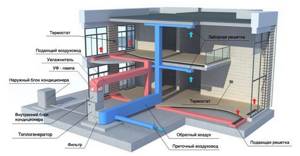
It is worth noting that this approach is suitable for heating small spaces, such as garages or workshops, which are used only from time to time. In this case, compact devices with a fan for air heating are used, which run on electricity or diesel fuel. The fan blows warm air into the room.
In large residential buildings, such installations are not used because they are uneconomical and ineffective.
What is air heating at home
If there is an air heating system in the house, for example Antares Comfort, Lennox, Nordyne or any other heating occurs by supplying warm air to each room of the house. Then the air that has given off the required heat is removed from the rooms, and in return a new portion of warm air enters the rooms. And this happens all the time, cycle after cycle.
In order for warm air to be supplied to the rooms of the house, any air heating system must consist of at least 3 parts:
- Heater to heat the air.
- A system of ducts through which heated air must be delivered to each room of the house
- A fan that delivers heated air through ducts to every room of the house
On our website there is an article Classification of air heating systems, which describes in more detail what types of air heating are.
For example, there is local air heating, which heats only one room or room - in this case, an air duct system is not needed. An example of local air heating is the well-known fan heater. However, a fan heater is the most primitive example of air heating, performing only one task - to heat the room. There is no question of any acceptable comfort in this case. Warm and ok.
If we return to the Americans and Canadians, their homes use centralized air gas heating, which, unlike a fan heater, heats the entire house at once, and not just one room. The possibilities of centralized air gas heating at home are much greater - it can be heating, ventilation, air purification, air conditioning, humidification with sterilization, and even intelligent control of the entire system - i.e. Centralized air gas heating at home can provide the maximum level of comfort. But, as already mentioned, we will return to comfort a little later.
Centralized air gas heating of a house has all 3 necessary components of air heating - a heater (gas air heating furnace), a fan, and an air duct system.
The figure below shows a diagram of the classic centralized American air gas heating of a Goodman house (with a gas air heating furnace - furnace):

A gas air heating stove with a built-in scroll fan is installed in the basement; an internal unit of duct air conditioner 2 can be installed on it (Americans cannot imagine life without air conditioning, but in our country, if you wish, you don’t have to install an air conditioner). Next, a large main air duct (red) is attached either to the indoor unit of the air conditioner or directly to the air heating furnace, through which the fan drives the air heated by the furnace into the house. Direct air ducts 5 are attached to the main air duct, through which heated air enters each room of the house. Cooled air is taken from the rooms through return air ducts 4, which are attached to the return main air duct (blue). I install ventilation grilles at the ends of both direct and return air ducts - for beauty. Modern ventilation grilles are very elegant, easily fit into the interior and even complement it. The return main air duct is attached to the air heating furnace 1 through an air purification filter 3, thus closing the air pumping system into a ring. It turns out that an air heating stove, using a built-in fan, constantly circulates the air of your home through itself, and constantly heats it up (and, if you have an air conditioner, cools it in the summer).
The diagram does not show another air duct - the ventilation duct. It is attached to the return main air duct. The ventilation duct brings a small portion of fresh air into the house for ventilation. Since the ventilation air duct is attached to the return main air duct, the street air is first purified by filter 3, then heated by an air heating furnace and only then supplied to the rooms of your house, already heated and purified. The air heating stove 1 runs on gas, so a chimney 9 must be attached to it, through which combustion products are thrown out into the street. If you want to have a higher level of comfort and healthier air in the house, a humidifier 10 is installed on the main air ducts, which accordingly humidifies the air, which is especially important in winter, when the air in our apartments and houses is very dry, which has a very adverse effect on the health of people and indoor plants. Pets can also suffer from dry air.
Now, having familiarized yourself with the general scheme of operation of air gas heating at home, you can understand why air heating systems are more economical and provide a better level of comfort than any other heating.
How does air heating equipment work?
Today there are 2 main types of such heating devices:
- Gravitational - after heating, the air circulates due to natural draft. The main advantage is that there is no need for additional electricity.
- With forced ventilation - they provide not only heat supply, but also draft due to the presence of a fan. Models of this class evenly distribute heat flows throughout the building even in the presence of drafts.
A high-quality air heating system allows you to create a comfortable microclimate in your home or business, which will preserve the health of people and the performance of other equipment located in the building.
Types of gas heat generators
Gas heaters for heating are divided into mobile and stationary. The latter, in turn, are divided into suspended and floor-mounted. At the same time, mobile units are less common because they use gas cylinders for their operation, which is not always convenient and possible to provide. That is why such devices are used only in extreme cases, for example, when the main heating in the room is turned off, and you urgently need to heat it when the temperature outside sharply drops. Also, such units are used as the main heating in regions with a short winter season.
The stationary type of heaters is used in various fields. Wall-mounted heat generators are hung on walls indoors and outdoors. Floor-standing devices, depending on the assembly features, can be horizontal or vertical. The former are more often used in low rooms, while the latter are suitable for installation in a private home or on the street. Floor-standing units are convenient to use for heating small rooms, installing them at the entrance and exit to the heated zone.
Construction of gas heat generators
A gas heat generator is a heater that heats the coolant (air) to the required temperature.
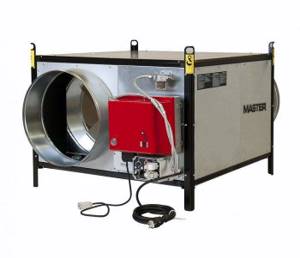
Its structure is as follows:
- The air fan is designed for uninterrupted supply of air masses and removal of exhaust air from the system. Exhaust air is exhausted upward.
- A gas burner burns fuel and heats the coolant.
- Complete combustion of the heat source occurs in the combustion chamber. If the fuel burns completely without any residue, then the volume of carbon dioxide that the system emits is small.
- The purpose of the heat exchanger is to ensure normal heat exchange between the room and the heat generator. In addition, the heat exchanger protects heating equipment from overheating.
- Air ducts are used to remove heated air into the room.
The operating principle of such heating equipment is as follows: a fan draws cold air into the device, it is heated during fuel combustion to the required temperature and discharged through air ducts into the room.
The operating process of a gas heater can be divided into the following stages:
- cold air from the street or room is drawn into the device by a fan and hits the heating element;
- since gas is constantly burned in the combustion chamber, thermal energy is released, which heats the air;
- after this, the fan supplies heated air to the heat exchanger;
- air ceilings are distributed through the air duct system through the use of air valves;
- Through the grilles, heated air is supplied to the room and gradually heats it up.
Calculation and selection of a gas generator
In order for the system to operate efficiently, the gas heater for air heating must be correctly selected
To do this, first of all you need to pay attention to the size of the heat exchanger. The dimensions of the heat holder should be 1/5 larger than the dimensions of the burner
To choose the right gas generator, you need to calculate its power. To do this, use the formula – Р=VхΔTхk/860, where:
- V in m3 indicates the heated area of the building;
- ΔT in °C is the difference in air temperature inside and outside the house;
- K is an indicator of the thermal insulation of a house (the number can be selected from a reference book);
- 860 - this number is a coefficient that allows you to convert kilocalories to kW.
The power of the device is selected in accordance with the obtained value. As a rule, the operating power of the equipment is indicated in its technical characteristics.
For uninterrupted operation of heating equipment for air heating, it is necessary to ensure a continuous supply of air to the device. For this purpose, the ventilation system of the structure must be properly equipped. If there are problems with ventilation, then it is better to use a hanging-type device that takes air from the street.
Price
You don’t have to make a heat generator yourself. There are ready-made devices available for sale. Finally, I will give the cost of some popular models:
| Model | Price in rubles |
| VTG 5.5 kW | 76400 |
| NTG-11 10.1 kW | 115000 |
| EUROMIX REV 100, 100 kW | 472000 |
| Euronord H 50 for premises up to 7500 m2 | 240 000 |
That's all the information about what a heat generator is.
Approximate price of air heating in a private house
| Options, rub. | |||
| Area, m2 | "Start" | "Start+" | "Climate" |
| 100 | 430 000 | 560 000 | 710 000 |
| 150 | 525 000 | 650 000 | 820 000 |
| 200 | 595 000 | 715 000 | 915 000 |
| 300 | 850 000 | 990 000 | 1 300 000 |
| 400 | 1 030 000 | 1 170 000 | 1 550 000 |
| Order |
“Start” option includes: ventilation, heating and air purification.
“Start+” option includes: the “Start” package, an air humidifier and increased air purification.
“Climate” option includes: “Start+” package, air cooling (conditioning).
